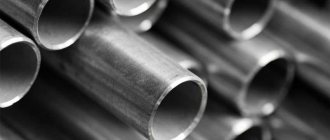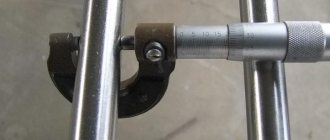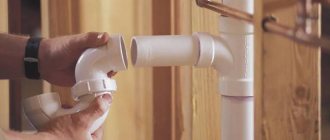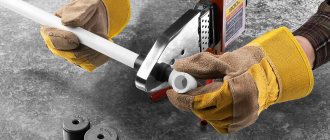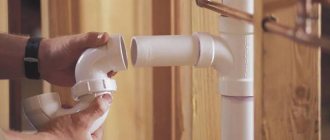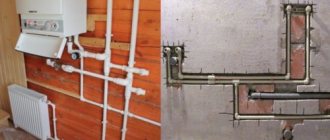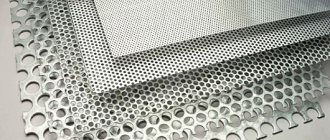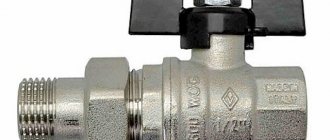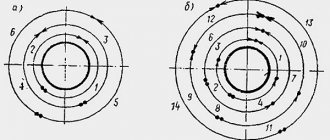Properties of polypropylene
Although polypropylene is the least dense of all plastics, it is more resistant to abrasion, tolerates heat better, begins to soften only at 140°C, is chemically resistant, and almost does not crack as a result of corrosion. The material is plastic. Under loads not exceeding the maximum, it stretches and then returns to its previous shape without any changes in properties and characteristics. So it's a really good and safe option. Pipelines in food factories are made from polypropylene pipes.
An additional plus is that polypropylene pipes are easy to connect - they are welded. In general, not only water pipes and heating are made from polypropylene. This material can be used as a frame for greenhouses, country furniture and a bunch of other useful things.
As you can see, the diameters of polypropylene pipes are different. And that's not all. There is also up to 1600 mm
Polypropylene has two disadvantages: high thermal expansion and reaction to oxygen and ultraviolet radiation. We learned to deal with both. In order for polypropylene to tolerate UV rays and light, stabilizers are added. To reduce thermal expansion, reinforced pipes are made. But even with reinforcement, the increase remains large and compensators must be installed in pipelines.
Another disadvantage of polypropylene pipes is that they become brittle at low temperatures. Some types begin to crumble at -5°C, others at -15°C. So external pipelines made of polypropylene require UV protection and insulation. That's why they probably prefer to bury them.
Diameter
The outer and inner diameters of steel pipes have different characteristics. They may be as follows.
- Conditional. Displays the nominal internal dimensions.
- Nominal. This is the actual size of the dimensions.
- Outer. This value is the main one when classifying large-volume products.
- Internal. This value is very important when choosing connecting elements for large volume pipes.
At the same time, the indicator of wall thickness for pipe-rolling materials of this type becomes no less important.
Certain fixed values for the outer diameter of these products are also known. They make it possible to select the required dimensions, taking into account the preliminary tasks of the structure being designed.
In reality, the outer diameter plays a significant role in certain situations. For example, when constructing units for drainage in premises, because in this situation fasteners are selected taking into account the values of the outer diameter of the main elements.
Types and purpose
Polypropylene pipes can be single-layer or three-layer. Single-layer ones are used for water supply, sewerage, ventilation and other pipelines with the temperature of the transported medium not exceeding +45°C.
Three-layer PPR pipes are reinforced. Reinforcement is designed to reduce the amount of thermal expansion and nothing more. PPR pipes are reinforced with fiberglass and foil. Those with glass fiber are suitable for hot water supply, provided that the water temperature is not higher than 80°C. For heating and systems where water can heat up above 80°C, foil-reinforced polypropylene is used. The foiling may not be continuous. For such pipes, the permissible temperature of the transported medium is +95°C.
Color is just a dye. It does not affect the properties in any way.
Can polypropylene pipes be used in underfloor heating systems? I guess, yes. The coolant temperature does not rise above +45°C, which is quite acceptable even for single-layer ones. But due to high thermal expansion, PPR pipes for heated floors are not the best option, even those reinforced with foil. There are more stable options and not more expensive.
Seamless hot-deformed steel
This type of pipe is the most expensive to manufacture and sell. By analogy with the previous category, some craftsmen want to find several options for carrying out work. This is one of the options for installing engineering systems. In this case, pipes are also divided into especially thick-walled, thick-walled and thin-walled. Depending on this parameter, the final weight is calculated, and the parameters include the maximum possible pressure in the system. Minimum – from 3 mm.
Pressure classification
Since a certain pressure is created in the pipeline to transport the medium, polypropylene pipes have this classification. There are four categories:
- PN10. Working pressure 10 Bar (1 MPa), maximum temperature +45°C. For cold water and low pressure systems.
- PN16. Withstands pressure up to 15 Bar (1.5 MPa), temperature up to +60°C. Also for cold water, but can also be installed in high-rise buildings.
- PN20. Pressure 20 Bar (2 MPa) and heating up to +75°C. Usually these are reinforced pipes, but with a small wall thickness. Used for hot water supply.
- PN25. The most durable pipes. Working pressure 25 Bar or 2.5 MPa, long-term heating up to +95°C. These are exclusively reinforced, and with a thick wall. They are used for hot water supply with unstable pressure (in high-rise buildings) and for heating distribution.
The presence of reinforcement is visible on the cut.
To make the fiberglass visible, it is tinted. Color - any If we talk about which PPR pipes can withstand what pressure, then single-layer pipes (without reinforcement) can be used up to PN20. The difference is in the wall thickness and this can be seen in the table. The outer diameters of polypropylene pipes do not mean anything (first column). The same external dimension can be designed for different pressures. It depends on the wall thickness and the presence/absence of reinforcement. So pipe marking is mandatory. The pressure class is indicated there.
| Outer diameters of polypropylene pipes, mm | PN 10 | PN 20 | PN 25 | |||
| Inner diameter, mm | Wall thickness, mm | Inner diameter, mm | Wall thickness, mm | Inner diameter, mm | Wall thickness, mm | |
| 16 | — | — | 10,6 | 2,7 | — | — |
| 20 | 16,2 | 1,9 | 13,2 | 3,4 | 13,2 | 3,4 |
| 25 | 20,4 | 2,3 | 16,6 | 4,2 | 16,6 | 4,2 |
| 32 | 26,0 | 3,0 | 21,2 | 5,4 | 21,2 | 3,0 |
| 40 | 32,6 | 3,7 | 26,6 | 6,7 | 26,6 | 3,7 |
| 50 | 40,8 | 4,6 | 33,2 | 8,4 | 33,2 | 4,6 |
| 63 | 51,4 | 5,8 | 42,0 | 10,5 | 42,0 | 5,8 |
| 75 | 61,2 | 6,9 | 50,0 | 12,5 | 50,0 | 6,9 |
| 90 | 73,6 | 8,2 | 60,0 | 15,0 | — | — |
| 110 | 90,0 | 10,0 | 73,2 | 18,4 | — | — |
Please note that the wall thickness in the third column - PN25 - is less than in the previous ones, although the pipes are designed for higher pressure. It's not a mistake. It's just that the pipes here are only reinforced. And in the previous two categories the wall thickness and diameters of polypropylene pipes without a reinforcing layer are indicated.
Steel electric-welded straight-seam
In straight-seam welded products, the metal thickness increases in increments of 0.2 mm. According to the standard, the wall thickness of electric welded steel pipe is from 1 mm to 32 mm. This is the only technology that produces products with a 1 mm wall.
Dimensions of steel electric-welded longitudinal pipes
When choosing straight-wood ones based on size and required metal strength, keep in mind that the seam is made with reinforcement. It is this gain that affects the total weight of the product and is approximately 1%. These products are suitable for a number of jobs and are made of sheet steel. The wall also depends on the passage opening of the product. More detailed information on the relationship between thickness and size, as well as the weight of the product, can be found in the corresponding section of the standard.
Marking of polypropylene pipes
As has already been said, it is impossible to determine by the outer diameter what pressure the pipe is designed for. Moreover, determining the type of material is also difficult. Therefore, all this information is indicated in the markings that are applied to the pipe. It repeats itself approximately every meter, so it’s simply impossible not to see it.
Marking of polypropylene pipes: let's look at an example
The first place is usually the name of the company or its logo. It is better not to buy unnamed pipes. But there is also a danger of falling for a fake if the company is well-known. You need to study the logo well and buy only if it matches completely. The following information is provided:
- The material from which the pipe is made. For polypropylene it is PP. A reinforcing material may also be specified. If it's aluminum it costs AL.
- Fiberglass - GF.
- Composite material with fiberglass - PPR-GF.
- PP-R100. These are pipes for pipelines with temperatures up to 100°C.
Decoding SDR for polypropylene pipes
So there is complete information that is necessary in order to decide where to use and under what conditions.
| Designation of the service class of PP pipes | Temperature of the transported medium (operating/maximum) in °C | Area of use |
| HV | up to 20 | Only for cold water supply. |
| 1 | 60/80 | For DHW with operating temperature 60°C. |
| 2 | 70/80 | For DHW with an operating temperature of 70°C. |
| 3 | 40/60 | For underfloor heating with coolant temperatures up to 40°C. |
| 4 | 60/70 | Heating and underfloor heating systems with an operating temperature not exceeding 60°C. |
| 5 | 80/90 | Heating and underfloor heating systems with an operating temperature not exceeding 800°C. |
Additionally, we recommend reading the article “How to choose the best polypropylene pipes.”
Pipe weight: how to calculate weight when purchasing
Most often, manufacturers who produce various types of metal pipes sell their products in wholesale quantities.
Individual parts are also sold, but the percentage is much lower compared to large orders placed by developers and individuals. On a note! Measuring the length of products that make up one batch is not a convenient solution. In order to simplify implementation, the cost is calculated taking into account the mass of the batch, which is determined based on the mass of the part. To calculate it, you need to know the weight of 1 meter of pipe. This is the fastest calculation method, but it is not the best for the customer. This is due to the fact that after using steel pipes, as a rule, a certain percentage of surplus remains.
To determine the mass of a batch in production, two methods are used. The first of them takes into account the use of an online calculator. This program allows you to quickly calculate the weight of steel parts. Often, an online calculator is posted on the website of a company that produces steel products. Thus, each buyer can determine the required batch weight in a matter of minutes and immediately place an order.
To determine the mass of a batch of pipes in production, you can use several different methods.
The second method to calculate the weight of steel pipe for purchase is weighing. It is produced using special cargo equipment. This operation is performed in 2 stages. First of all, the car (or trailer) is placed on the scales, which allows you to determine its weight. Next, a batch of metal parts is loaded into it. The initial weight of the vehicle is subtracted from the resulting figure to obtain the total mass of the batch.
Each buyer can come to production if it is necessary to determine other characteristics of the batch. For example, you may need to calculate the number of pipes in one order. It is also very often necessary to know the length of products. As a result, carrying out such calculations will allow you to place an order not by weight, but by the number of packages.
Read the continuation of the article on the next page. To move to the next part of the article, use the page navigation numbers.
Connection method
As already mentioned, polypropylene is joined by welding. But despite the high level of plasticity, the minimum bending radius does not allow making turns even at an angle of 90°, not to mention steeper ones. All branches and turns are made using fittings. These are special elements for connecting plastic pipes. This is a whole range of different parts for each diameter.
Fittings for polypropylene pipes: types and varieties
The difference is that the marking indicates the diameter of the pipe for which these elements are intended. So you don't need any sizing. If you are using a pipe, say, with a diameter of 25 mm, then simply take fittings with the same marking. It is better to buy both from the same company. Then there will be no problems. If you had to take products from different companies, try them on to be sure. Take a piece of pipe to the store and check compatibility. It should fit in without any problems, but tightly, without gaps.
Diameters of steel pipes and their wall thickness in mm. Dependence of one parameter on another
Steel pipes are actively used in various industries and agriculture. Their reliability has been tested by time.
Of course, such products have their drawbacks, in particular, a tendency to corrosion. But everyone is already quite well informed about these shortcomings.
Timely preventive and repair activities make it possible to maintain engineering systems based on metal pipes in perfect order.
The main characteristic of steel pipes is their diameter. We can say that, based on the diameter of the pipe, a decision is made about its use in a particular engineering system, in a particular section of the system.
Features of steel products
In the building materials markets you can find pipes of two main designs:
- welded, having a seam;
- seamless - obtained, for example, by casting.

